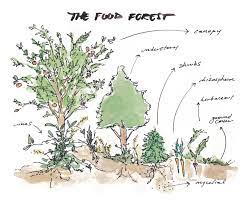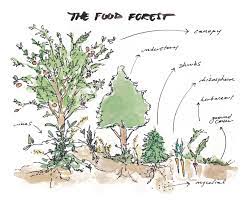Courtesy : permacultureapprentice.com
Food forest
One of my earliest memories of visiting my grandparents’ farm was playing on the dry stone wall, tossing stones around, and just generally fooling around.
Then, looking down, I came across a small seedling sticking out the side of the wall, growing in nothing, with barely any soil between the stones.
Out of childish curiosity more than anything I decided to set it free from the heavy stones and leave it to grow on its own. That was 20 years ago…

Today, that seedling is this strapping young fellow on the image left – European Ash tree.
He has survived the droughts, heavy snows, pouring rains, and sub-zero temperatures all by himself, without anyone taking care of him.
As I sit under his shadow today and plan my food forest I’m curious to find out how trees flourish without human intervention.
How come wild apples, plums, and cherries from the nearby forest do so well while the cherry tree I planted in my orchard five years ago has died miserably? To understand this I needed to return to the place where the seed of this Mountain Ash tree came from and revisit my teacher – the forest itself.
Forests Are Our Teachers
Just by my house, some 50m away is an entrance to a forest. I visit there often, it makes me feel relaxed, I enjoy the serene sounds of nature, the falling leaves, birds, and other critters. Most importantly, I go there to observe and learn.

You see, given enough time every ecosystem ends up like a forest. This is the endpoint of ecological succession; a point where the ecosystem becomes stable or self-perpetuating as a climax community and, without any major disturbances, the forest will endure indefinitely.
This is exactly what you want your own food forest to be like. To achieve a low maintenance abundance of fruit, nuts, berries and herbs you’ll want to create a forest-like system where fertility comes from various sources, where you’re greatly aided by fungi, where wildlife is your primary pest control, where soil holds water like a sponge, and where you have a high diversity of plants.
You want a carefully designed and maintained ecosystem of useful plants and emulate conditions found in the forest.
However, the problem is often that you’ll find yourself starting out with a bare field, a blank canvas and the overall plan can feel a little overwhelming. Sometimes even reading books such as Edible Forest Gardens can make things harder rather than easier.
While creating my own food forest, I broke down the plan into smaller, manageable steps. I want to make as few mistakes as possible and to be honest, I don’t have time to make them.
So today I’ll let you in on my process and I’ll also share additional resources that will help you go from that bare field to a fully-functioning ecosystem inspired by forests.

FREE DOWNLOAD: grab my exclusive free resources with practical tips on food forest design.
Ok, let’s dive in!
1. What Do You Want From Your Food Forest?
First, you have to be clear about the ultimate goals of your project.
Why is this important?
You see, with a clear goal, everything becomes easier, you know where best to place your efforts and, most importantly, what are the priorities, what to focus on and what to postpone for the time being.
You have to think are you doing this because of: 1. being more self-reliant, 2. making an income, 3. producing healthy food 4. educating others 5. having a fun project for all the family
As you can see, each of these will require different considerations for your precious time and money. For example, if your goal is to create an income from your food forest, you’ll want to focus on researching which tree crops sell well locally and then think about how to grow them in the most efficient manner.
On the other hand, if you just want to be more self-reliant, you’ll want to think about how to create a diverse food forest with as many fruits, nuts and herbs as possible to fulfill your needs and stop being dependent on the grocery store.
Don’t overdo the thinking at the outset, but just be clear what you want from the beginning.
2. Explore, Sit Quietly and Observe, Analyse
–> Explore your local forest so you’ll have an idea what will grow best in your area
Start with taking casual walks in your local forest. When designing a food forest you want to learn from the local ecosystem and try to emulate it. This is why such observations are important, this is how you discover what plants will grow best in our area.
You’ll want to look around and identify the plants that are thriving. As Mark Shepard would say: identify the perennial plants, observe how they grow in relation to one another, and take a note of the species. Later on, you can use that list to find commercial productive variants of the wild plants that you can grow in your food forest.
This step is crucial, because if you want to create an edible landscape that requires less work and maintenance, you need to grow species that are well adapted to your area, i.e. species that are volunteering to grow around your site.
If you have nature as your ally and use the natural tendencies of the native vegetation, then you’ll be doing considerably less hard work. This is one of the fundamental permaculture principles of working with nature rather than against it.
For example, when I walked in my forest I saw elderberries, hazels, hawthorns, lindens, cherries, apples, junipers, and the list goes on. So, guess what I’ll be growing in my food forest?
I’d also be taking seeds from those naturalized species and using them as rootstock for my plants. But that’s a lesson in itself, so be sure to read my post on growing trees from seeds.





